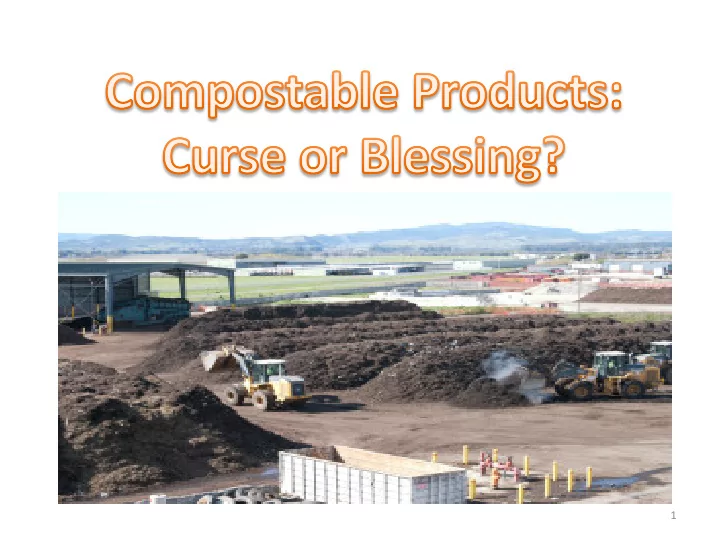

1
– A compostable resins and products manufacturer – A compost facility operator – A compostable product end-user – A solid waste consultant – A compost industry associate – A solid waste hauler – A Sonoma County Waste Management agent – A zero-waste event consultant – A community stakeholder 2
• Recognize the challenges and benefits of including compostable plastic products as part of the Sonoma County organics diversion program • Identify potential options for effectively resolving those challenges to allow compostable plastic products to be a component of organics diversion programs. 3
• Feedstock --raw material for fuel • Biodegradable ---degradation resulting from the action of naturally occurring microorganisms such as bacteria, fungi, and algae • Bioplastic --biodegradable plastics derived from biological substances • Compostable Plastics —plastics capable of biological decomposition in a compost site and can return nutrients to soil 4
• Polyethylene Terephthalate (PET) ---a widely used petroleum-based, clear, strong, lightweight plastic • Polylactic Acid Plastic (PLA): a plastic substitute usually made from fermented plant starch (typically corn) • Biodegradable Products Institute (BPI): North American organization that certifies compostable products and packaging 5
• Compostable foodservice packaging does not negatively or positively affect the balance of C:N, nutrients, moisture, or feedstock porosity… • Diverse compostable foodservice packaging performs as well as wood and other bulking agents in compost production… • Bioplastics support a rural, agrarian economy and can be grown all over the world 6
Compostable plastic… • is already part of the foodservice packaging landscape. • can be produced from existing manufacturing equipment. • such as PLA will not emit toxic fumes when incinerated. • could help reduce dependency on petroleum products. • can reduce carbon dioxide when compared to other plastics. 7
• Compostable plastics do not add any nutritional value to the soil. • Methods used to grow renewable bioplastic feedstock have a large footprint. • There is pollution from fertilizers and land diverted from food production. • PLA has a higher up-front cost to produce that is passed on to consumers. • When compared to petroleum-based plastics, bioplastics such as PLA are deficient in strength and crystallinity. 8
• “At the end of the active composting process…visible fragments of non-composted foodservice packaging were observed, requiring an three extra weeks…to disintegrate.” • Biodegradable or compostable plastics have to be separated from other plastics and sent to an equipped industrial composting facility which most municipalities don’t have. • Compostable plastics are confused with other plastic and therefore typically landfilled or end up in marine environments. • PLA bottles in a landfill could take anywhere from 100 to 1,000 years to decompose. 9
• Particles of most of the common classes of plastics found in people. • Research is needed to determine if bioplastic such as PLA releases nanoparticles that potentially pose a health and environmental threat. • Bioplastic such as PLA is often made from genetically modified corn. Costs to the environment and health are still largely unknown and could be very high. • PLA’s low glass transition temperature makes it unsuitable for hot liquid 10
1. Fiber Only Compostable —Food scraps and unlined paper products; organic certified 2. Food Scraps and BPI Certified Compostable Single Stream — non-organic 3. Food Scraps and BPI Certified Compostable Dual Stream Onsite — ½ organic certified, ½ non-organic 4. BPI Certified Compostable Single Stream Outsourced— on- site certified organic 11
1. Fiber Only Compostable — Cost effective=1 2. Food Scraps and BPI Certified Compostable Single Stream Cost effective=4 3 . Food Scraps and BPI Certified Compostable Dual Stream Onsite Cost effective=3 4 . BPI Certified Compostable Single Stream Outsourced Cost effective=2 12
W. Edwards Deming 13
• Member “Spotlight” • Code of Conduct • Composting options with pros, cons, and financial implications. • Educate ourselves as to the realities and best practices of composting materials and methods. • Decisions through a voting process: a.) agreement, b.) ok but with some reservations, and c.) disagreement. • Produce a report that describes options, pros and cons, and associated costs that can be used to select a model for Sonoma County. • Emerge as friends and colleagues. 14
• Operate on short statements and move conversation to others, do not monolog (i.e. 30 sec to 1 min) • Listening and restating (less defensiveness) • Genuine open questions and open mindedness • Stay engaged • Minimal interruptions • Acknowledgements to validate and minimize defensiveness • Respect at all times • Positive • Bicycle lot 15
1. “Compostable Plastic Products” Sonoma Compost, 2008 2. “Life Cycle Inventory of Five Products Produced from Polylactide (PLA) and Petroleum Based Resins Technical Report” Athena International, Franklin Associates, 2006 3. Compostable Plastics 101: An Overview of Compostable Plastics 4. “PET bottles potential health hazard” Sohn, Emily, News in Science, 2009 5. “Field Study: Foodservice Packaging as Compost Facility Feedstock “, Foodservice Packaging Institute, Inc. , October, 2018 6. “The Environmental Impact of Corn-Based Plastics” The Environmental Magazine 7. “Humans Are Pooping Plastic, And No One’s Certain How Bad That Is” Vidal, John, Huffington Post, December, 2018 8. “Greenhouse Gas Impacts of Disposable vs. Reusable Foodservice Products”, Sheehan, Bill, Clean Water Fund, January, 2017 9. “PLA Plastic – All You Need to Know About PLA Material in 2019” All3DP, 2019 10. “What you need to know about plant-based plastics” National Geographic, November, 2018 11. “What’s the Difference: Biodegradable and Compostable”, Organic News and Environment, June, 2018 16
Recommend
More recommend